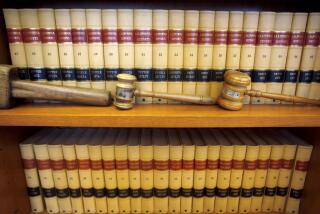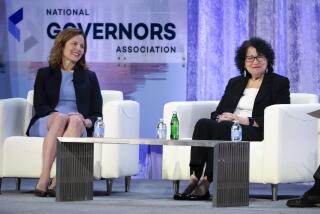Supreme Court watchers eye Sonia Sotomayor
- Share via
WASHINGTON — Since her name surfaced last week as a prime contender for a seat on the Supreme Court, Sonia Sotomayor, a federal appeals judge in New York, has already become an object of scorn and praise, of blistering attacks and spirited defenses.
Sotomayor is the subject of intense early scrutiny partly because she appeals, demographically at least, to two of President Obama’s key constituencies: women and Latinos.
The case for a second female justice has been widely touted in Congress and by women’s groups. But with about 45 million Latinos in the U.S., leaders say it is high time for the first Latino justice, male or female.
“There will be great displeasure among Latinos and Latino leaders” if they are passed over again, as they were by the Bush administration, said Ramona Romero, president of the Hispanic National Bar Assn. “My phone hasn’t stopped ringing since Justice [David H.] Souter’s planned retirement came out. This is an issue of deep importance to our community.”
But the fact that there aren’t a lot of viable candidates with Sotomayor’s attributes raises another challenge for the president: how to balance the various lobbies with his own constitutional law professor’s eye for legal ability as well as his desire for someone who has demonstrated empathy.
Thomas Goldstein, a Washington lawyer who regularly argues before the court, said the president would find no viable candidates if he asked for a “45-to-50-year-old Hispanic woman with great life experience” who “is a heavily credentialed lawyer with an impeccable background.”
“Nobody knows who that person is,” he said. “Something is going to have to give.”
Sotomayor, 54, offers a compelling life story that may appeal to Obama. A child of Puerto Rican parents, she grew up in a housing project in the South Bronx. She excelled as a student and graduated from Princeton University and Yale Law School.
Her ascent on the federal bench was bipartisan. President George H.W. Bush named her a U.S. district judge, a post she assumed in 1992. Six years later, she was elevated to the U.S. 2nd Circuit Court of Appeals, chosen by President Clinton.
But more recently, she has been the subject of sharp criticism -- much of it from unnamed clerks and lawyers -- who say she can be abusive to lawyers and domineering in the courtroom. That has spurred counterattacks from supporters. They say she is being unfairly demeaned for her sharp questioning, which, they say, is mild in comparison with, for example, Justice Antonin Scalia’s.
Obama has spoken of the nomination in general terms. He has said he wants someone with a diverse background, who has empathy for “people’s hopes and struggles” -- perhaps a candidate who does not hail from traditional academic or judicial circles.
But he also is a former law professor who would probably want a nominee of sterling academic achievement who can hold his or her own with intellectual heavyweights on the high court. He is also expected to seek a candidate young enough to potentially serve for at least two decades.
He has yet to suggest that the choice must be a woman or minority. Interest groups, however, have been doing that for him. There is a near-universal belief beyond the White House that the pick will be a woman. Obama is also being pressed to name the first Asian American or the first African American woman to the court.
“I don’t think he can do it all now,” said Lee Epstein, a Northwestern University law professor. “Who out there meets all of these various little boxes?”
Though the large Democratic majority in the Senate means that Obama has some latitude in his choice, Republicans promised this week to push back if they perceive the nominee is beholden to specific minority or interest groups.
“The president is free to nominate whomever he likes,” Sen. Mitch McConnell of Kentucky, the Republican leader, said Tuesday. “But picking judges based on his or her perceived sympathy for certain groups or individuals undermines the faith Americans have in our judicial system.”
Obama has been careful to not make public promises. That’s in contrast with President Reagan, who campaigned on a pledge to name the court’s first female justice. He followed through, choosing Sandra Day O’Connor in 1981.
After Ruth Bader Ginsburg joined the bench in 1993, there were two female justices until O’Connor retired in early 2006.
Women’s groups are clear in their position that the new nominee should not be a man.
“We would be disappointed if it is not a woman,” said Marcia Greenberger, co-president of the National Women’s Law Center. “It is not acceptable to have only one woman on the Supreme Court.”
--
david.savage@latimes.com
More to Read
Get the L.A. Times Politics newsletter
Deeply reported insights into legislation, politics and policy from Sacramento, Washington and beyond. In your inbox twice per week.
You may occasionally receive promotional content from the Los Angeles Times.










